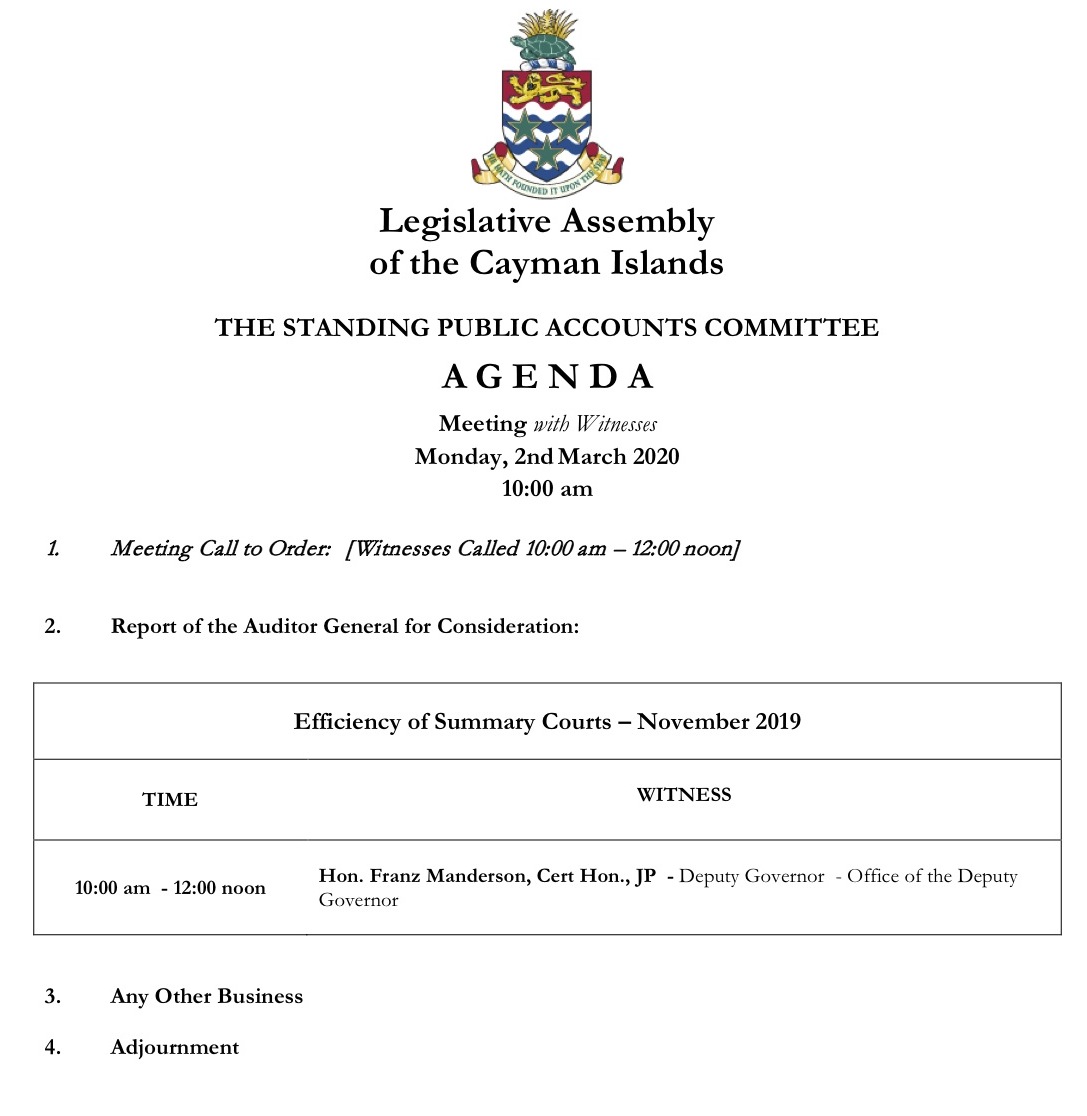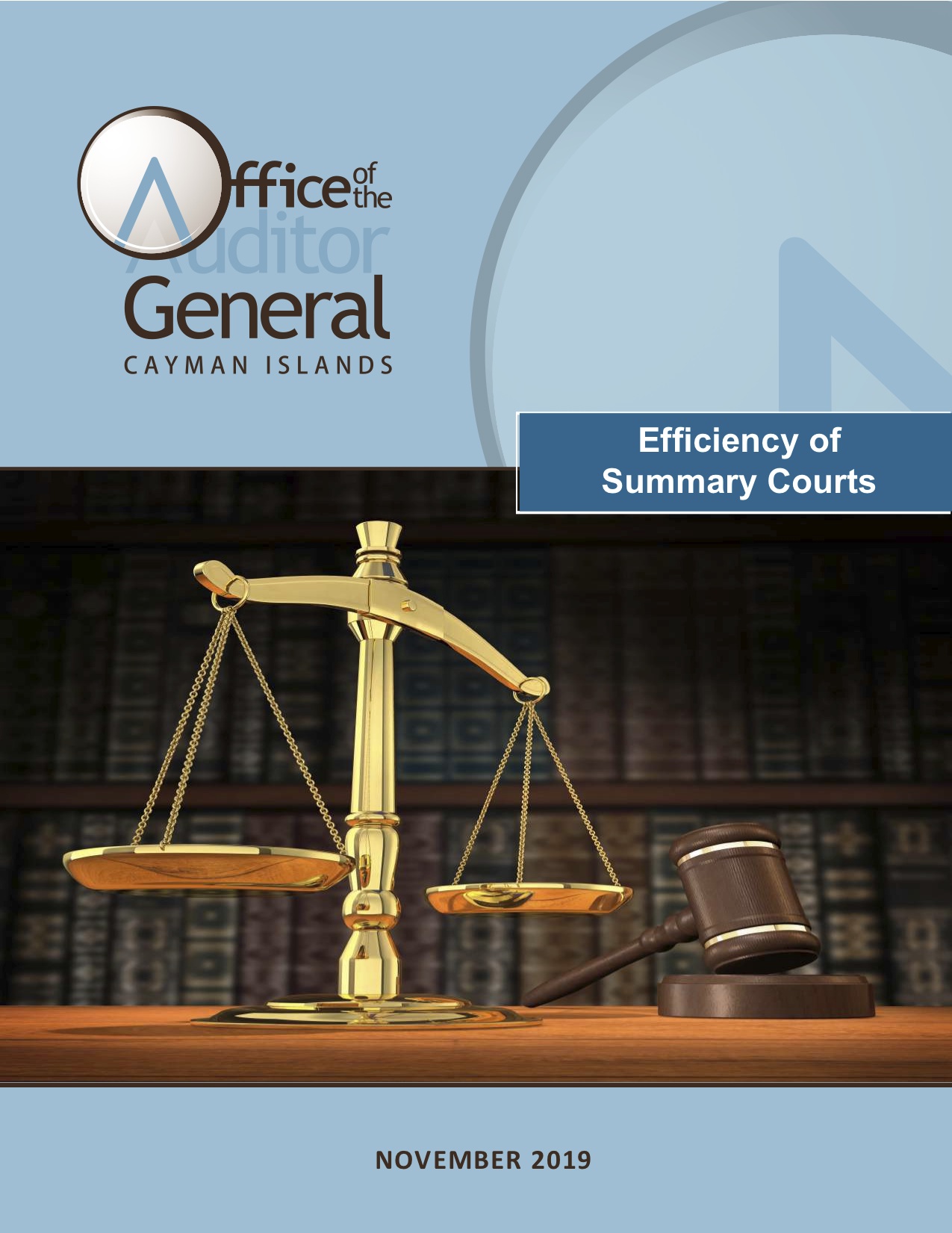Cayman: Next public hearing of PAC will discuss Efficiency of Summary Courts
The Chairman of the Public Accounts Committee has scheduled a public hearing for Monday, 2 March 2020 at 10:00 am.



EXECUTIVE SUMMARY
The importance of an efficient and effective justice system in promoting a fair and democratic society and contributing to economic growth is well documented. Fair, accessible and efficient courts serve to create positive relations among citizens and between the individual citizen and the state, helping to build public trust and confidence in the courts. In his January 2019 speech marking the opening of the Grand Court, the Chief Justice referred to the World Bank’s 2016 report, “Good Practices for Courts.”
Prosecuting cases through the Summary Courts involves a number of public bodies. The main organisation responsible for operating the Cayman Islands court system is Judicial Administration, which administers all of the courts. However, the Office of the Director of Public Prosecutions (ODPP), the Royal Cayman Islands Police Service (RCIPS), the Cayman Islands Prison Service (CIPS) and the Department of Community Rehabilitation (DCR) also play significant roles in the criminal justice process. In addition, a wide range of individuals are involved in cases coming before the court, including the accused, their defense lawyers, jurors, victims and witnesses.
Over the years, a number of concerns have been raised about the efficiency of the Cayman Islands court system. The Chief Justice has frequently stated that a lack of court space is a major factor in delays and inefficiencies. In 2018, Judicial Administration purchased the Scotia building, close to the existing courthouse, to create more courtrooms. This is a significant financial investment, and the Legislative Assembly Public Accounts Committee asked the Auditor General to carry out a performance audit of court efficiency to ensure that this investment would deliver value for money.
The objective of this audit was to evaluate the efficiency of the Cayman Islands judicial system in handling Summary Court (including Traffic Court) cases. It sought to answer the following audit questions:
• • •
How is the judicial system currently performing? Is Judicial Administration using its resources efficiently and effectively? Does Judicial Administration have an effective relationship with stakeholders and court users?
KEY MESSAGES
Judicial Administration has limited performance information and does not use the information available to understand, manage or improve performance. There are a number of widely accepted measures for assessing the performance of courts that could be used. These include, for example, the length of time cases take to progress through the system, the number of times cases are heard when they are scheduled, and views of court users.
Neither Judicial Administration nor the Criminal Justice Board have agreed performance standards or are using any performance measures to understand how efficiently or effectively the Summary Courts are working and where improvements could be made. The performance measures specified in the Strategic Policy Statement (SPS) are input- and output-based, rather than stated as outcomes to be achieved, so they will not help drive performance improvements. There is no evidence that Judicial Administration or the Criminal Justice Board considers the performance of the judicial system against the SPS measures, and performance is not publicly reported. The IT system currently used by Judicial Administration is not capable of producing useful performance information without extensive manual input. The lack of performance information and any monitoring or reporting makes it is difficult to tell whether value for money is being achieved.
There are inefficiencies in the way cases are processed through the Summary Courts, but a number of these could be addressed through better use of technology. Judicial Administration is currently undertaking a major upgrade of its IT system. This has the potential to improve efficiency and reduce bureaucracy, for example, by allowing on-line payment of traffic fines. However, there is no business case documenting the costs and intended benefits of the system, so it will be difficult to measure value for money and how the system will contribute to improvements in efficiency.
The complex and multi-agency nature of the Summary Court system means it is difficult to identify the total cost involved in prosecuting cases through the Summary Courts. Judicial Administration’s budget for 2018 was $15.2 million. Our analysis of the budget statements and estimates shows that $4.8 million of this budget was allocated to support court proceedings, including $1.99 million for Criminal and Traffic Courts and $1.96 million for Civil Court proceedings. However, Judicial Administration does not record its expenditures in this way.
The total cost of processing cases through the Summary Courts also involves elements of the budgets of the RCIPS, the ODPP, the CIPS and the DCR. The financial systems of each of these organisations are designed to manage and monitor the expenditures of that organisation, and only some of their expenditures will be directly related to processing cases through the Summary Court. Without an understanding of performance or of the costs relating to the Summary Courts, it is difficult to make an evidence-based assessment about whether Judicial Administration is using its resources efficiently and effectively.
The current court buildings are not fit for purpose and previous proposals for a new court building have been declined on the grounds of affordability. While the plans for the new court building are well advanced, at the time of our audit there had been limited engagement with other justice organisations to identify their requirements for the new court building. These could include, for example, the need for specialist accommodation for vulnerable witnesses, or for secure accommodation for people attending court from prison. Judicial Administration needs to engage with both internal and external stakeholders to ensure that the new court buildings meet their requirements. A draft Outline Business Case (OBC) for the project was being prepared at the time of our report. It is important that the OBC is in line with good practice to ensure that it provides a strong evidence-base to justify the need for and investment in the new court building; this is not available currently.
Justice partners work well together at an operational level, but there is a need for more strategic collaboration to improve the efficiency and effectiveness of the justice system as a whole. Individual organisations and managers understand their own responsibilities, and there is a Criminal Justice Board that operates as a court users’ group. However, there is no senior strategic board with shared responsibility for ensuring that the entire justice system operates efficiently and effectively. As a result, there is limited collective understanding and consideration of the criminal justice system as a whole and how changes implemented by one organisation can impact on the workload of others, which likely causes inefficiencies in the system.
CONCLUSION
- The Public Accounts Committee asked me to carry out a performance audit on court efficiency to ensure that the investment in the new court house would deliver value for money. The need for a new court house is not in question as the current court facilities are not fit for purpose. However, at the time of the audit the Outline Business Case for the project was still draft and had some major gaps. Specifically, no support was presented on why ten court rooms were needed and this appears to be based on experience rather than an analysis of current and projected workload. We understand that the most recent projections of workload were done in 2015. We also found that dialogue with other justice partners, including RCIPS, Prison, Director of Public Prosecutions and the Department of Community Rehabilitation, to determine their needs in designing the new court house had only recently started. It is important that in planning and designing the new court house the needs of justice partners are factored in to help improve efficiency of the entire justice system and ensure the safety and security of court users. In addition, the estimated cost of the project is not yet clear. All of these factors combined currently make it difficult to assess that there is value for money from the proposed investment.
- It is difficult to assess the overall efficiency and effectiveness of Summary Courts and therefore Judicial Administration as there is limited performance information. The current Information Technology (IT) system is of limited use in producing useful performance information and neither Judicial Administration nor the Criminal Justice Board considers the performance of the court system against the outputs specified in the Strategic Policy Statement. We also found that Judicial Administration does not record costs by type of court or case, despite the budget being set in this way. In addition, Judicial Administration has not done any workforce planning to determine what staffing it needs to operate efficiently and effectively. A robust performance measurement framework, supported by financial analysis; and a workforce plan are essential elements of strategic planning and I have recommended that these are developed by Judicial Administration.
- We found a number of inefficiencies in the system, some of which could be resolved through better use of technology. I note that Judicial Administration is in the process of upgrading its IT systems for the entire court system and the priority is the Financial Division. This IT upgrade has the potential to significantly improve the efficiency of Summary Courts, for example, by moving to online payments, e-ticketing and electronic court scheduling. I encourage Judicial Administration to roll out the new IT system to all courts as soon as possible.
- Finally, there is scope to improve the justice system as a whole by establishing a high-level, strategic group made up of the most senior officers in all of the justice bodies to discuss and consider the efficiency and effectiveness of the entire justice system. This group could provide opportunities to discuss proposed in one organisation and the potential knock-on consequencies of these for others, which could help decision making and planning.
Sue Winspear, CPA
Auditor general
Cayman Islands





